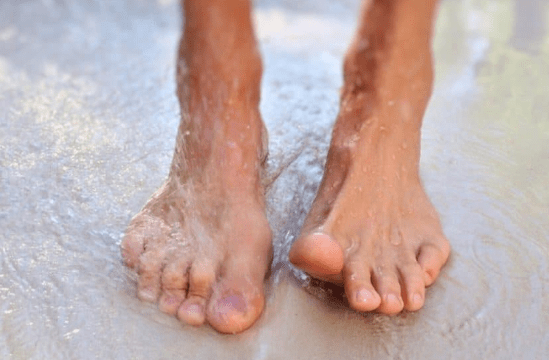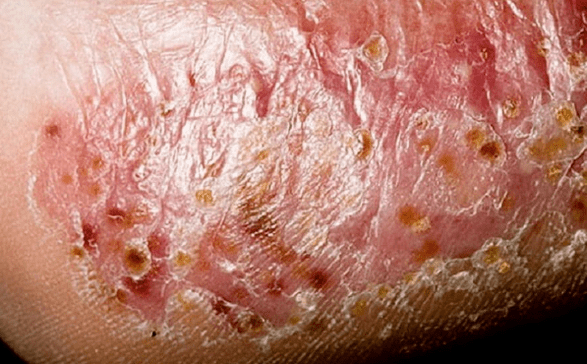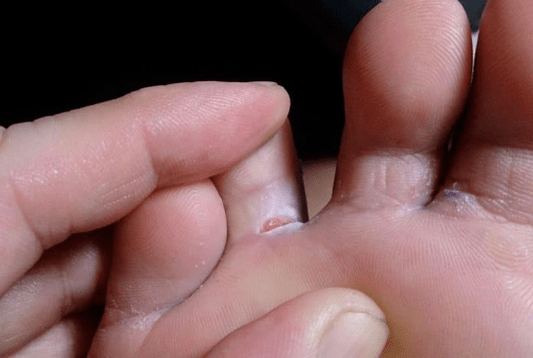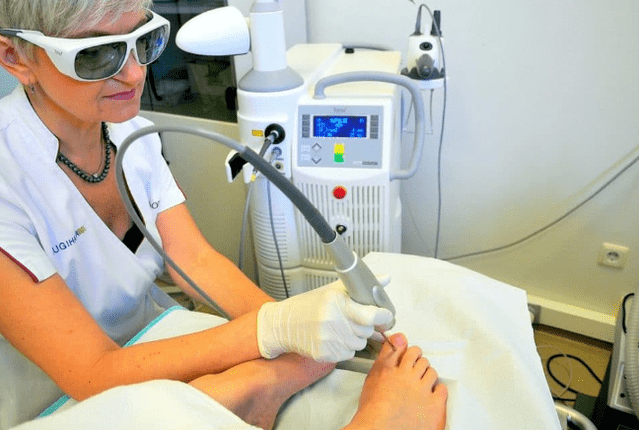This is the general name of infectious diseases that affect the foot of a person, nails on the legs or arms.In medicine, such pathologies are called mycose - a whole group of ailments provoked by microscopic fungi.
Onychomycosis is distinguished - damage to the nails, and dermatomycosis - is localized on the skin of the legs.The disease is often an independent disorder, as a rule, it develops against the background of disorders of various genesis.What the foot fungus looks like, the localization of the pathogen type depends.

There are a large number of species of fungi, however, only some of them cause pathological changes in humans.Micosis of the feet occupy the prevalence of 2nd place among all skin diseases.The following groups of fungi are distinguished, which are dangerous to health:
- Anthropophilic.I provoke pathologies only in people, you can get infected from another person.
- Zooanthropophilic.They can cause illness in animals too, infection comes from animals and other people.
- Candidate.A separate type of yeast fungi, which has its own characteristics.
There are several types of pathologies that have similar signs, this includes rubromicosis and epidermophytosis.They are combined under the general definition of “Mikoza Stop”.Symptoms of the fungus on the legs are divided depending on the type, but often they develop in parallel, so this distinction is conditional.The following forms of pathology are distinguished:
- scaly;
- interiginosny;
- Dyshidrotic;
- Onychomycosis, which is divided into: normotrophic, atrophic, hypertrophic.
The scientific name of the disease is onychomycosis.The infection affects the skin, mainly on the lower extremities, the nail plates.Yeast and molds fall on an unprotected surface.
The foot fungus is a fairly common disease transmitted by people through the overall use of objects.It is noteworthy that its distribution occurs extremely quickly, while the development of the disease is concentrated in the area of the areas between the fingers on the legs.
Causes
Infection under consideration occurs with direct contact with the fungus, the reproduction of which occurs extremely quickly in the environment of warm and wet surfaces of the skin.It is possible to infect the fungus of the foot as a result of contact made with the human skin with his fungus.
The situations in which the transmission of the fungus is carried out by means of tools used for manicure and pedicure, as well as through shoes and towels, is no exception.
Most often, the foot damage to the foot occurs among people who have problems with excess weight and circulation in the legs of blood, and people with the deformation of the feet are often subjected to it.Violations in the immune system, caused by an unhealthy lifestyle, stress, use antibiotics in the treatment of antibiotics, as well as malnutrition, also determine the possibility of infection with the fungus of the foot.
Wet skin, cracks, irritation on the foot, pathogenic and conditionally pathogenic fungi cause pathogenic and conditionally.The types of fungus are as follows:
- Pathogenic species of mushrooms when it enters the skin leads to the development of the inflammatory process, a fungal disease occurs;
- Conditionally pathogenic microorganisms are constantly on the skin, and increased activity is manifested only with the action of provoking factors.
The source of infection is people suffering from mycosis.Pathogenic flora enters healthy skin in places of accumulation of people.Comfortably various types of mushrooms develop in conditions of heat and high humidity.
Places of infection:
- pools;
- baths;
- locker rooms in sports centers;
- public showers;
- saunas;
- Fitness centers.

Important!Never go barefoot in common areas.For classes at a sports club, pool, when going to the steam room, take special shoes with you.
Some professions are at risk.The reason is a long stay of the legs in a closed, warm, humid environment.The fungal skin lesions often suffer:
- miners;
- athletes;
- military;
- Hot shop workers.
Pay attention!Mycoses often develop in those who are obliged to wear closed shoes, regardless of whether they are comfortable to their feet or not.The job description for many professions prescribes boots as a special unit even in the hot season.It is very difficult to fight mycosis in such conditions.
Other causes of fungal diseases:
- bad hygiene of the legs;
- skin trauma;
- reduced immunity;
- fitting shoes without a nylon sock;
- Complications for diabetes.
Types and symptoms of a foot fungus
There are many varieties of fungus.
The skin of the feet most often affect the following types:

- Red trichophyte injures the feet and heels;
- Interdigital trichophyte is distributed to the inter -backing zone, and in advanced cases affects the feet, the skin of the thumb and the epidermis on the little finger;
- Trichophyte MentagrophyTes - a type of fungal infection that develops in the skin on the human body (armpits, inguinal folds);
- Candida fungus - infection causes candidiasis of the mucous membranes and genitals, but there are also lesions of the skin of the feet.
Dermatophyte can cause local lesion of the skin.The name of such a disease of epidermophytosis is a very contagious pathology, which intensively develops on the human body.
There are three forms of foot fungus:
- Interdalz dermatophytosis in acute and chronic forms;
- Mochacino-Sicut;
- Vesicular, ulcerative.
General symptoms of the disease are severe itching and burning, skin irritation, followed by peeling of particles.It is these signs that can most often be seen on the photo on the Internet with which the Internet is full.
Interdalz dermatophytosis
What is this form?The most common, mainly localized between the 4th and 5th finger of the foot.It occurs in the form of cracks: with a wet form, the skin looks swollen, and with a dry piece it peel and fall off.
Often, along with the interdald dermatologists-fitia, other bacterial infections are striking in the foot.The advanced form begins.Symptoms are enhanced, unpleasant sensations - too, the patient feels severe pain, which cannot get rid of.
The initial stage of the interdigital shape of the fungus.
If the skin cracked, blood can act, causing additional suffering.The psychological factor comes in - some people are trying to independently tear off the peeling particles of the skin, and this is not recommended to do this, since a new infection occurs.The disease is aggravated.
The common name "foot athletes" is about this shape of the fungus on the feet.It is quite difficult, caused with the neglect of treatment, but it is easiest to recognize.With this pathology, nail plates are affected, which begin to change color to black, green, blue or yellow.Transparency is lost, the nails are gradually deformed, pour and crumble.
The foot at that moment peels, covers with scales on the sides.The leg becomes like a moccasin.
A fairly rare form of the disease, when compared with interdaltsevo and mochacino-sicut.Blisters with muddy liquid are manifested over the entire surface of the foot.Over time, they ripen and burst.
The photo is presented with the ulcerative shape of the foot fungus
Additional signs noticed in patients are:
- constant itching and burning;
- peeling, the skin is laying;
- fingertips, which are also infected with a fungus in contact with infected parts of the body;
- swelling of the feet;
- Sometimes body temperature increases greatly.
The causes of the development of the disease
The source of the disease is a person with a fungus of the foot, whose skin particles remained on objects or in places of public use.It can be baths, pools, locker rooms and showers.Onychomycosis feels great with high humidity and is stable at low temperature.
Most often, the causes of the development of the disease are:

- Antisanitaria in beauty salons, when pedicure tools do not process or do it badly;
- the use of other people's things - towels, washcloths, combs;
- insufficient hygiene, increased sweating of the legs.
Non -compliance with hygiene or excessive sweating of the legs leads to the fungus of the foot
But one contact with the microorganism-exciter is not enough.There are additional risk factors that exacerbate the situation and enhance, accelerate the development of the disease.
These include:
- injuries of the foot and nail, because when infected, the disease often switches to the skin;
- Reducing immunity.As soon as this happens, microorganisms begin to attack with a vengeance, getting rid of them becomes much more difficult;
- HIV infection;
- bad habits - alcoholism, smoking, overeating;
- cardiovascular diseases, diabetes mellitus;
- Lymphostasis of the lower extremities.
Stages and their manifestations
The defeat of the legs with microorganisms of pathogenic flora has several stages or clinical forms of its development on the skin:
- echoed or initial stage;
- interdigital infection;
- Squamous-Hyperkeratotic shape;
- Dyshidrotic stage (wet fungus).
Folk remedies for the treatment of fungus
Folk methods of treatment can only be used as an auxiliary agent.As the main method of treatment of fungus, folk remedies are ineffective, but can enhance the therapeutic effect of drugs.
First of all, baths are used.They have an antifungal effect and steam the skin, improves the penetration of the components of ointments and solutions from the fungus into the deep layers of the epidermis.Baths can be done according to the following recipes.
- Add 4 tablespoons of vinegar to the basin with water and steam your legs for 15 minutes.
- Take two tablespoons of salt, soda and iodine solution for 4 liters of water.
- Add boric acid powder to the bath at the rate of 10 g per 2 liters of water.
- Dissolve four tablespoons of tar soap in a basin with hot water, add half a glass of soda.
- Add 100 g of soda and juice of one lemon to the bath with water.Fresh juice can be replaced with 10 drops of lemon essential oil.
Baths must be done daily throughout the entire treatment period.They are recommended to be used before applying an antifungal agent.With the mushroom of the foot, you can use lotions.Tincture of propolis helps to accelerate recovery.It must be mixed equally with water, and then moisten a cotton swab in the resulting solution and treat the skin of the legs.
To date, there are many recipes for traditional medicine, the effectiveness of which is largely inferior to some drugs.It is worth noting that a positive result of alternative therapy can only be observed at the initial stage of the development of fungal infection.The advanced form of mycosis of the stop is not subject to traditional medicine.
The drugs of traditional medicine, like various medications, can be useless in the treatment of fungus on the legs.But, there are such, the effectiveness of which has been proven for many centuries.
Tea tree essential oil is the best remedy that does not cause a danger to a general state of health.Therefore, it can be safely used in pediatrics.Due to the presence of antiseptic action, the development of pathogenic fungus is blocked under its influence.
To prepare the therapeutic ointment, mix the aloe vera gel and tea tree oil in a ratio of 1: 3.This tool is rubbed into the affected areas twice a day.Such manipulations are recommended to be carried out daily for three months.


























